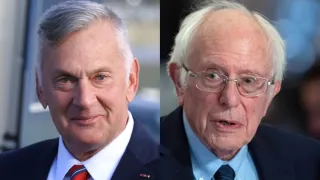Trump changed the news media — and it’s not going back, with or without him
Nobody likes the mainstream media. After all, many people say, it’s controlled by untrustworthy elites who restrict the flow of information and dictate what we know. Journalism would be so much better if readers and viewers called the shots.
Newsflash: They do. And it isn’t.
In the midst of a uniquely consequential presidential campaign, two studies published last month indicate media trust is at an all-time low. A Knight Foundation poll of 20,000 people showed Americans’ “hope for an objective media is all but lost.” Instead, 80 percent see a media “eager to push an agenda.” A Pew study revealed news consumers often question “the intention behind” journalists’ work.
All this has led to soul-searching from some news professionals about the perceived rise of “advocacy journalism” in the mainstream press during the Trump years. Those critics are not off-base — but they’re pointing an accusatory finger in the wrong direction.
First, some background. Advocacy journalism has been around a long time, going back at least 100 years to the so-called “muckrakers,” investigative reporters who uncovered societal failures such as squalid slum conditions and child labor exploitation. Their reporting was typically focused on a cause; they pushed for new laws and regulations. In the 1960s, documentaries like CBS’s “Harvest of Shame” about migrant farmworkers continued that tradition of exposing abuse and encouraging change.
These investigations were not “political,” in the sense of setting one party against the other. Instead, they were meant to stir awareness in the overall population.
Today’s advocacy is something different — focused more on politics, party, culture and division. In this brand of advocacy journalism, reporting feels predetermined: Story angles seem to check boxes on that “agenda” cited in recent polling; who the heroes and villains are depends on which news outlet you’re consuming.
Donald Trump is, of course, the catalyst behind this. His attacks on journalism and his elastic relationship with the truth have compelled some news organizations to reconsider the ideal of “objectivity” and push back openly against the president in their reporting.
But this trend won’t go away once Trump is gone, no matter when that may be. As the president himself says, he’s been good for the news business — too good. He’s helped bolster a new journalism economic model, subscriptions, that delivers clout to news consumers and changes the financial imperatives of the profession.
Mainstream news once depended on advertisers for survival. Those advertisers by and large hate taking sides, which encouraged news objectivity as a sure path to profits. But when you ask a reader or viewer to shell out cash to subscribe, they apparently expect more in return than your basic who-what-when-where-why reporting.
Some news consumers who insist they want a product they can “trust” often really want something that reflects their own self-portrait — right or left — especially in the Trump Era. In a sense, they see supporting journalism as something like a fashion choice or a car purchase — an image-building exercise. As a result, they appear willing to jump over a pretty high paywall to live inside a well-guarded news community, a place that offers few challenges to preconceived notions. This puts pressure on news executives to follow the money in their story choices — and that often produces advocacy journalism.
Walled-off information environments play on what psychologists call the “bias blind spot,” the notion that most individuals view themselves as unbiased while seeing enormous bias in everyone else. That blind spot allows the Fox News audience to consider their channel “fair and balanced,” and readers of the New York Times to agree they’re getting “all the news that’s fit to print” — meaning that anything else is, well, not fair or fit.
Trump or no Trump, advertising will continue to fade and subscriptions expand, for television as well as print. The cable business is increasingly challenged by cord-cutters; news channels will depend more and more on viewers to pay them directly for TV apps. That puts consumers even more firmly in the driver’s seat and places additional pressure on editors and producers to deliver what their paying customers expect.
The only antidote to this is heightened media literacy. News consumers need to be skeptical even of the journalism that reinforces their world view — and very skeptical if they are fed nothing but stories that confirm their opinions.
Knowing how to spot that in our news — and in ourselves — is not easy, but it’s the only way to burst the various bubbles we now find ourselves in.
Joe Ferullo is an award-winning media executive, producer and journalist and former executive vice president of programming for CBS Television Distribution. He was a news executive for NBC, a writer-producer for “Dateline NBC,” and worked for ABC News. Follow him on Twitter @ironworker1.
Copyright 2025 Nexstar Media, Inc. All rights reserved. This material may not be published, broadcast, rewritten, or redistributed. regular














